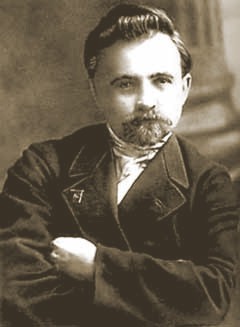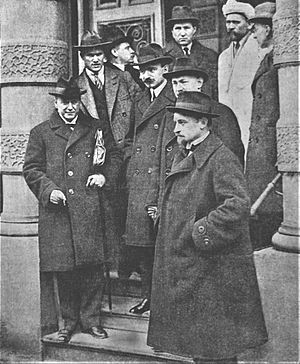Yevgeni Preobrazhensky facts for kids
Quick facts for kids
Yevgeni Preobrazhensky
|
|
|---|---|
 |
|
| Member of the 9th Secretariat | |
| In office 5 April 1920 – 16 March 1921 |
|
| Personal details | |
| Born | 15 February 1886 (Old Style) Bolkhov, Oryol Governorate, Russian Empire |
| Died | 13 February 1937 (aged 50) Moscow, Russian SFSR, Soviet Union |
| Cause of death | Execution |
| Political party | RSDLP (Bolsheviks) (1903–1918) Russian Communist Party (1918–1927, 1930–1933) |
Yevgeni Alekseyevich Preobrazhensky (Russian: Евге́ний Алексе́евич Преображе́нский; 1886–1937) was an important figure in the early Soviet Union. He was a Russian revolutionary, an economist, and a sociologist. He was a member of the powerful Central Committee of the Bolshevik party, which later became the Communist Party.
Preobrazhensky is known for his ideas on how to quickly industrialize, or build up factories and industries, in Russia. He believed the government should focus on developing state-owned heavy industries.
He was a close friend of Leon Trotsky and part of a group called the Left Opposition in the 1920s. This group disagreed with Stalin, who later became the leader. Preobrazhensky tried to make peace with Stalin in 1929. However, he later secretly joined forces with Trotsky again in 1932. He was arrested in 1933 and died in 1937 during a time known as the Great Purge.
Contents
Early Life and Education
Yevgeni Alekseyevich Preobrazhensky was born on February 15, 1886, in Bolkhov, a town in the Russian Empire. His father was an Orthodox priest who also ran a school. Yevgeni first learned to read and study at his father's school.
He was a very smart child and learned to read at just four years old. After his father's school, he attended a state public school in Bolkhov. Later, he went to a gymnasium (a type of high school) in Oryol, where he was one of the top students.
Becoming Interested in Politics
During his time at the Oryol gymnasium, Yevgeni became very interested in politics. He started reading newspapers, journals, and history books. At 14, he decided he no longer believed in religion. This caused problems with his father.
He also began collecting illegal revolutionary writings. These included protests from students and radical poems. When he returned home, he decided to join the movement to overthrow the Tsarist government in Russia.
Joining the Revolution
Preobrazhensky decided to focus less on school and more on studying history and economics. He wanted to help the revolutionary movement. He even tried to set up a secret printing press with a friend to print revolutionary pamphlets. However, his equipment was not good enough.
He had to choose between two main revolutionary groups: the peasant-focused Socialist-Revolutionary Party and the Marxist Russian Social Democratic Labour Party (RSDLP). After reading important books like the Communist Manifesto, he chose the RSDLP. He officially joined with two friends in late 1903.
First Steps as a Revolutionary
When the Russo-Japanese War began, Preobrazhensky and his friends helped distribute anti-war messages from the RSDLP. They secretly put over 150 copies into the coat pockets of older students. The police investigated, but they were never caught. All three were then accepted as full members of the RSDLP.
During the summer before his last year of high school, Preobrazhensky worked as a propagandist, spreading revolutionary ideas to factory workers. He even managed to hide a small printing machine in a police inspector's desk! In October 1905, he joined the party committee in Oryol. By this time, the RSDLP had split into two groups: the Bolsheviks, led by Vladimir Lenin, and the Mensheviks. Preobrazhensky, at 19, was one of only two strong Bolsheviks on the committee.
In November 1905, he moved to Moscow and became a chief propagandist there. For the next 12 years, he traveled and worked as a professional revolutionary. He was arrested several times. In 1917, after the February Revolution, he returned to the Urals. He was elected to the regional party committee and later became an alternate member of the Bolshevik Party's Central Committee.
Years in Power

From 1918, Preobrazhensky held important positions in the Bolshevik Party. He was the head of the Ural Regional Committee of the Communist Party in May 1918. This was when Nicholas II, the former Tsar, and his family were killed in Yekaterinburg. Preobrazhensky knew about this decision beforehand and discussed it with Lenin.
In 1918, he joined a group called the Left Communists. They were against the harsh peace treaty with Germany called the Treaty of Brest-Litovsk. During this time, he became close friends with Nikolai Bukharin, another important Left Communist leader.
In 1919, Preobrazhensky co-wrote a famous book called The ABC of Communism with Nikolai Bukharin. He also wrote other important essays about how an economy changes towards socialism.
Leading the Party Secretariat
Preobrazhensky became a full member of the Central Committee of the Russian Communist Party in March 1920. He was also chosen as one of three secretaries of the Central Committee. This was the most powerful job he ever had. The other two secretaries were often sick, so Preobrazhensky did most of the work. He was effectively in charge of how the party was run.
During this time, the party staff grew to over 600 people. A new system was created to track party members. This system was later used by Joseph Stalin to control and remove people who disagreed with him. However, Preobrazhensky believed in more freedom for people to criticize the party.
In March 1921, there was a big disagreement at the Tenth Party Congress about the role of trade unions. Preobrazhensky supported Leon Trotsky in this debate, while Lenin supported the other side. After a rebellion, Lenin decided to ban organized groups within the party. Because of this, Preobrazhensky and the other two secretaries lost their jobs and their Central Committee membership.
After this, Preobrazhensky was appointed to lead the party's Financial Committee. He also became a leading Soviet economist in the 1920s. He helped create plans for the country's industrialisation and disagreed with the New Economic Policy, which allowed some private business. From 1924, he was an editor for Pravda, a major newspaper.
The Left Opposition
Preobrazhensky was an early leader of the Left Opposition. This group openly disagreed with Stalin after Lenin's death. He was a main author of "The Declaration of 46," which asked for more freedom to express different ideas within the Communist Party. It also criticized the party's leaders for not having a plan for the economic crisis.
He also developed a theory called Primitive socialist accumulation. This idea suggested that the government would need to buy farm products cheaply and sell manufactured goods at higher prices. This would create money to invest in new industries. He wrote about these ideas in articles and in his 1926 book, The New Economics. These economic ideas were central to the Left Opposition, bringing Trotsky and Preobrazhensky together.
Preobrazhensky and Trotsky believed that the Soviet Union needed to industrialize quickly. They worried that rich peasants, called kulaks, could become too powerful. They argued that the government should use different prices to gather money from the countryside to fund industrial growth.
This plan was different from what Stalin and Bukharin wanted. Stalin and Bukharin believed the rich peasants were under control. They wanted to lower prices and improve the quality of goods to encourage peasants to produce more food.
Personality and Expulsion
Isaac Deutscher, who wrote about Trotsky, described Preobrazhensky as a very knowledgeable scholar. He said Preobrazhensky would follow his ideas wherever they led, even if it made him unpopular. Many people thought Preobrazhensky, not Trotsky, was the true creator of the Opposition's economic plan.
Victor Serge, who met Preobrazhensky, remembered that he worked so hard he often looked tired. But his mind was always sharp and full of facts.
Being Expelled from the Party
In 1927, the United Opposition, including Preobrazhensky, wrote a detailed "Platform" criticizing the party's direction. Trotsky wanted the party to publish it, but Stalin refused. However, copies were still made and shared secretly.
In September 1927, the secret police found a printing press used to print these opposition writings. They arrested Sergei Mrachkovsky, who was running the press. The government tried to discredit the opposition by claiming they were working with a former enemy officer. Stalin later admitted this officer was actually a police informer.
Preobrazhensky and another leader, Leonid Serebryakov, admitted they were partly responsible for the press. Because of this, they were expelled from the party in October. This was the first time important older Bolsheviks were expelled.
In January 1928, Preobrazhensky was sent to the Ural Mountains to work in planning.
Return and Final Arrest
In April 1929, Preobrazhensky wrote a public appeal. He said that since Stalin had changed the party's direction towards rapid industrialization, the opposition should now support the party. He was allowed to go to Moscow to discuss returning to the party. In July 1929, he and two others signed a letter saying they had broken with Trotsky's ideas. About 400 other exiled members followed their lead.
In January 1930, Preobrazhensky was allowed back into the Communist Party. He was given new jobs in planning and in government departments.
However, at some point, he secretly joined an opposition group. This group later formed a secret alliance with Leon Trotsky in 1932. In January 1933, Preobrazhensky was arrested again by the secret police. He was accused of being part of a "counter-revolutionary Trotskyist group." He was sentenced to three years of exile and expelled from the party again. But he was readmitted later in 1933.
In February 1934, Preobrazhensky was allowed to speak at the 17th Party Congress. He said he was "ashamed" of his past actions and praised Stalin's "tremendous insight" and "courage."
He was arrested a second time on December 20, 1936. Unlike some of his old friends, he was not put on public trial. Historian Robert Conquest wrote that Preobrazhensky showed great courage by not making a false confession, even under pressure.
Preobrazhensky was arrested again on January 2, 1937. On July 13, 1937, a secret court sentenced him to death, and he was executed the same day. Many years later, in 1988, the Soviet government officially cleared his name.
Economic Ideas
Preobrazhensky's main economic idea was about "socialist primitive accumulation." He argued that the Soviet Union, like early capitalist countries, needed to gather resources to invest in industry. He believed this meant taking the extra food produced by peasants to fund new factories and development.
This idea was linked to Trotsky and the Left Opposition. However, some historians argue that Stalin later put a similar idea into practice in the 1930s. Stalin said the Soviet Union needed to achieve in a decade what other countries took centuries to do, to prepare for possible invasions.
Works
English Translations
- ABC of Communism: Volume 1. With Nikolai Bukharin. 1921.
- Third Anniversary of the Russian Revolution. 1921.
- The New Economics. 1965.
- From NEP to Socialism: A Glance into the Future of Russia and Europe. 1973.
- The Crisis of Soviet Industrialization: Selected Essays. 1980.
- The Decline of Capitalism. 1985.
- The Preobrazhensky Papers: Archival Documents and Materials: Volume I, 1886-1920. 2015.
Images for kids
See also
 In Spanish: Yevgueni Preobrazhenski para niños
In Spanish: Yevgueni Preobrazhenski para niños


